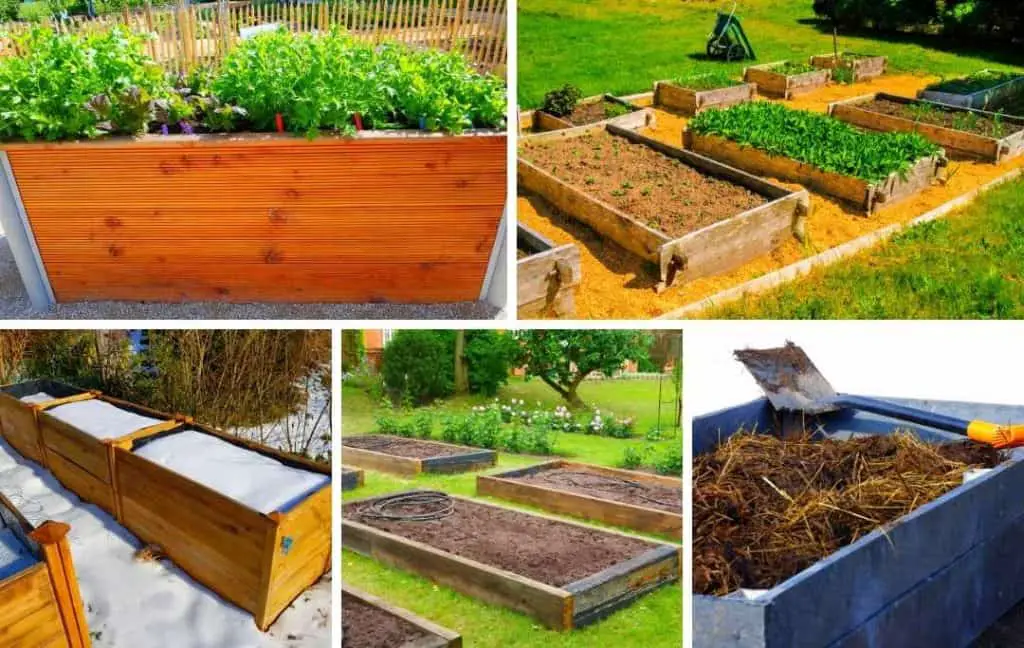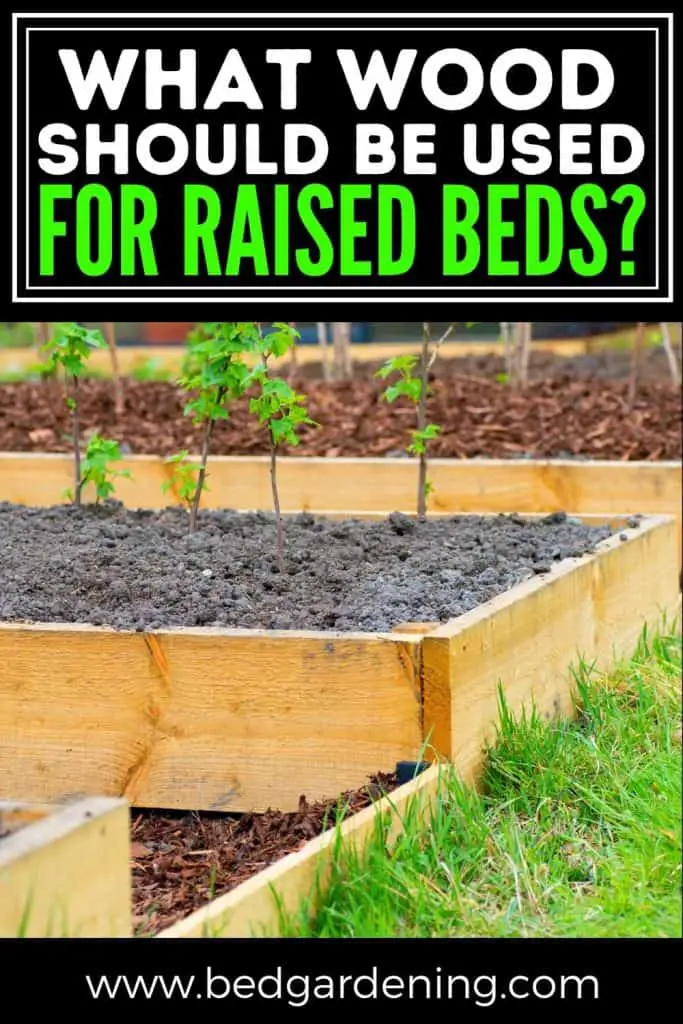Raised beds are garden containers in which you can grow your favorite plants. If you want to build a wooden raised bed for your garden then it is simply a wooden box that may be square or rectangle. If you are a beginner and you don’t have knowledge about materials of raised beds and you need them for your garden or backyard.
Before buying or building raised beds you need some proper research about them. You can also grow plants in the ground but raised beds have many benefits such as you can avoid kneeling and bending and you can easily move them.
When you decide to build a raised bed, the first question that arises in your mind is what type of material you can use for making a raised bed. There are different types of material available for making raised beds such as wood, galvanized steel, cinder blocks, rock, concrete, and more.

The most common option is wood. When you decide the material you use will be wood, now you face the difficulty of what type of wood is the best for your raised bed. You can build raised beds from cedar, spruce, redwood, pine, or composite wood. Before selecting the type of food we should consider durability, safety, and weather-resistant qualities. In this article, we were going to discuss what kind of wood you should use for building your raised bed.
TYPES OF WOOD FOR BUILDING RAISED BED
It’s up to you what type of wood you will choose for your raised beds. But your decision should be according to your needs and requirements. Beautiful, durable, and chemical-free material should be your choice for building boxes for your plants.
But at that same time, the material should be durable for many decades and perform a good job of nourishing your crops. Here we are going to explain some types of wood which definitely will help you to decide what type of wood you want for your raised beds. But your choice should be chemical-free or we can say that untreated wood.
Read More: 15 BEST WOODEN RAISED GARDEN BEDS
1- CEDAR
The first and best option is cedar. It is a rot-resistant wood and can last about 10 to 15 years. If you add it to your garden then it looks stunning and extraordinary. Cedarwood is relatively lightweight, so, it will be easy for you to bring it home. If your budget is low then you can’t afford it because it is more expensive than other cheaper woods.
As you are not using treated wood that’s why the color of cedar wood will fade to a silver-grey as you place your raised bed in sunlight. If you want to preserve the original color of the cedar then the outside of the wood can be treated with tung oil to retain its bright colors.
Don’t waste your time and energy by choosing the old treated wood for building a raised bed but choose that option that is best for you.
2- REDWOOD OR BLACK LOCUST
If you talk about durability then definitely the best option is redwood because it can last up to 20 years which is a long period. The other important benefit of this board is that it is rot resistant.
It has a beautiful and elegant color. It is chemical-free and you should try to buy FSC certified redwood only for the sake of your plants. Although it is very expensive, if you compare its price with cheaper wood, it will run 4 times the cost of cheaper wood.
3- JUNIPER
This wood can last more than 50 years. It is rot and bug resistant and works well when contact with dirt. Juniper is the best wood as it helps your veggies to grow in a chemical-free environment. It is inexpensive and recommended by many gardeners. The problem is that it has just a rustic look which is not appealing for everyone.
4- PRESSURE TREATED WOOD
It is also included in the options although it is controversial because again and again, we are informing you that it is not good for your edible plants. This would be easily available in most of the areas. Its lifespan is about 20 years.
Most of the thrifty gardeners try to buy this wood because it is very inexpensive and most of the time they get it free. The worst thing about this wood is that it contains chemical preservation which is not good for your garden soil and as a result of your veggies.
The purpose of these chemicals is to protect your wood from decay and rot but the chemicals which enter the soil through this material may migrate into food which is not a healthy sign.
Read More: 28 BEST VEGETABLES TO GROW IN RAISED BEDS
5- RECLAIMED WOOD
This board has a rustic and charming look. It is usually inexpensive. The problem is finding the right sizes of this type of wood for your raised beds. It contains unknown chemical additives and lead paint which is not good for your soil. Try to avoid using such types of wood as you don’t know the purpose of paint.
6- PINE
You can also use pine boards for building raised beds but pine is not the best choice. It is not as durable as cedar and its wood is soft. If your pocket is not allowing you to buy cedar then pine is a good option. It can last up to 5 years and is not rot-resistant. If you want your raised beds to last long then you should paint them with linseed oil.
7- DOUGLAS FIR
Another option for making raised beds is a Douglas fir which can last up to 5 to 7 years. This word is very cheap and can be used for making raised garden boxes. If you don’t want your raised beds for a long time then this option is best.
8- COMPOSITE WOOD
This type of wood Is a blend of wood fiber and UV-protected recycled polypropylene. Its color is earth brown and has a grain texture. These timbers are very lightweight and it is very easy to lift them and assemble them. Its appearance is just like natural solid wood and it is weather and rot-resistant.
The boards of this timber are hollow, that’s why they can be damaged easily. If you want to build a tall and long raised bed then this material is not suitable for this purpose because if the weight increases it puts pressure on the side of the bed and it can bow them outward.
9- HEMLOCK
Wood is a popular choice for building raised beds as it is cheaper than other materials such as galvanized metal. If you are living in a termite territory then you can’t install a wooden raised bed as termites are enemies of wood. The raised beds which are built from hemlock can last up to 7 years. It is a favorite of most of the gardeners. If your budget is low then hemlock can be used as a less costly alternative to Cedar.

THINGS YOU SHOULD CONSIDER BEFORE SELECTING THE WOOD
The important things you should consider before buying the wood for your raised beds are locally sourced and sustainable, FSC certified, rot-resistant, and untreated. The wood selection depends upon your region and best for your plant’s health.
1- LOCAL AND SUSTAINABLE
If you are looking for the best wood at a cheap price then you should prefer locally- sourced wood. This wood comes from sustainably managed tree farms. You should avoid using the old-growth trees which are cut for clearing the area.
2- FSC CERTIFIED
If it is possible for you then you should always prefer to use FSC (Forest Stewardship Council) certified wood this is a non-profit organization which aims to promote the responsible management of forests.
3- SAFETY CONSIDERATIONS
Try to use treated lumber especially if you are growing vegetables and fruits. Because it concerns your health as you will eat your grown edibles from the garden. Most of the manufacturers specifically mentioned that the wood is treated or untreated.
It means that before using the wood you should research properly. It is important to know that what you add to your soil, it will go into the water, in plants and affect your health, so you should be careful.
Some wood treated methods are
- Alkaline Copper Quaternary (ACQ)
- Copper Azole (CA)
- Micronized Copper Quaternary (MCQ)
- Sodium Borate ( SBX)
If it is necessary for you to use treated wood then you can use a protective layer of plastic. In this way, you will create a barrier between the wood and the soil and protect your plants. Again, before using the plastic you have to check that it is food safe.
4- DO NOT USE CCA WOOD
Don’t use pressure-treated wood or old railway ties. This wood is CCA (Chromated Copper Arsenate ). Many years ago, this type of wood was banned from using household purposes. This wood is used for industrial purposes and can’t be used for planting purposes. Don’t try to repurpose this type of wood which seems to be in good condition because it is not a good option.
5- DURABILITY AND ROT-RESISTANCE
Everyone wants durable material for making raised beds. The durability of wood is depending on many things such as climatic conditions and type of wood. For example untreated fine and last about 10 years if you are living in such a place where the rain is moderate and your soil is well-drained.
If you are living in a rainy area and raised beds will be exposed to a lot of moisture then it is not possible pine can last 10 years. Another big problem is termites which are enemies of wood.
6- BEST SIZE FOR YOUR RAISED BEDS
After arranging all the materials you need for building raised beds which are wooden boards, nails or screws, a measuring tape, a hammer, and a drill. Before starting to build the raised bed, first take the measurement. In this way, you will minimize waste cuts. The size of the raised bed according to your garden.
But the width of the raised bed allows you to access your plants. If your beds are too wide then the plants which are at the center will be neglected. The best width of your raised bed should be 2, 3, or 4 feet and the best length for your raised bed should be 4, 6, 8, 10, or 12 feet.
The standard size for raised beds is 4 by 8-foot rectangular boxes. This size is suitable for you to reach your plants easily. It will make the maintenance of your plants very easy.
